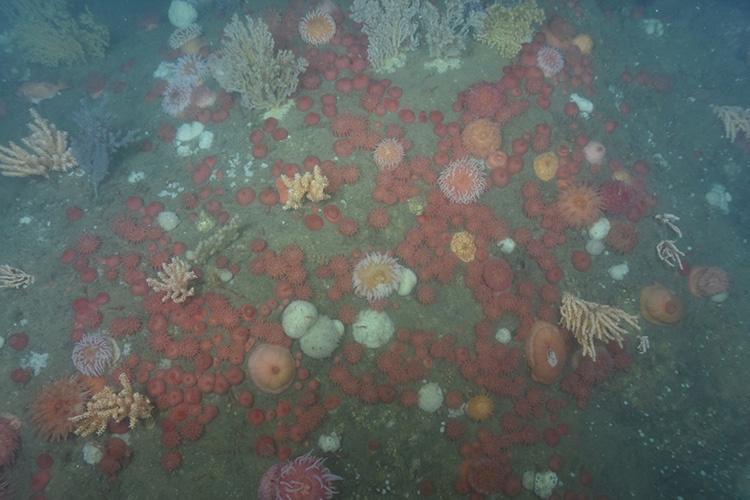Chief Scientist’s Weather Report: A weak high pressure ridge will move across the waters Friday through Saturday, bringing with it the threat of an overwhelming number of corals.
We had planned on staying in the Northeast Channel for more surveys, but knowing that the weather was going to deteriorate the next day, we high-tailed it into the calmer waters of the U.S. Gulf of Maine to explore sites in Western Jordan Basin (June 21) and Outer Schoodic Ridges (June 22), parts of which we’ve surveyed in previous years.
Deep-sea coral habitat is spatially rare in the U.S. side of the Gulf of Maine. In the past, deep-sea corals may have been fairly common on hard substrates, but now the more dense populations of deep-sea corals are only found in areas of rough topography where they are relatively inaccessible to impacts from fishing gear. Gulf of Maine deep-sea coral habitats are very different than those in the canyons (see Vive la Difference! from our 2017 cruise) mainly because they are relatively shallow (between about 170-250 meters), nearshore, and have only two predominant species of coral: Primnoa and Paramuricea, which are often found in high densities.


As in 2017, we wanted to delineate the boundaries and extent of these deep-sea coral habitats. For Western Jordan Basin, we planned to survey those unexplored areas that we predicted from the maps of the seafloor to be hard substrate and high relief (“bumps,” with boulders, outcrops, slopes, walls, cliffs) and thus, good coral habitat), focusing on a promising area east of most of our previous surveys. And as before, it did not disappoint. There were abundant and extensive “coral gardens” containing often dense groupings of Primnoa and Paramuricea, the latter coming in two different colors: yellow and purple. (The ones with purple coloration may be unique to the Gulf.)
Primnoa seemed to dominate the more vertical habitat such as walls, while Paramuricea wasn’t necessarily confined to high relief areas, but could be found attached to mud covered gravel, cobbles, and boulders interspersed in flat areas but in small numbers and small sizes. There were also areas with dense patches of sponges and anemones.

We were very excited to find some bubblegum coral, which has not been seen in Western Jordan Basin since surveys done in 2002 or 2003. It was found at a depth of 238 meters, which maybe the shallowest it’s ever been seen. It was only one colony, but we’ll accept it!
Outer Schoodic Ridges is a unique area in the Gulf. The tortuous topography here reminded us of the slot canyons in Utah. It has a series of muddy patches bounded by steep and narrow walls. Previous surveys have found incredibly dense patches of Primnoa hanging from steep, vertical walls – an amazing sight.

Outer Schoodic Ridges has been tough to survey because of the presence of lobster pots, which we needed to avoid. We managed to find our way into an area that we hadn’t explored before. Yet again, we discovered new, extensive areas of Primnoa and Paramuricea, and the corals often occurred in high densities. Primnoa on the walls were also a host to incredibly high numbers of redfish. It could only be described as magnificent. And, for the first time, we found some bubblegum coral here (one large and one small colony), but even shallower than at Western Jordan Basin, at 176 meters, so it might break the depth record that was made the day before!
These relatively shallow, nearshore deep-sea coral habitats are unique in the U.S. side of the Gulf of Maine. Discovering new areas with deep-sea corals even in places that have already been surveyed is an illustration of how much more we need to understand about the Gulf of Maine ecosystem in order to better conserve and manage our natural resources.
Dave Packer, NOAA Fisheries Northeast Fisheries Science Center



